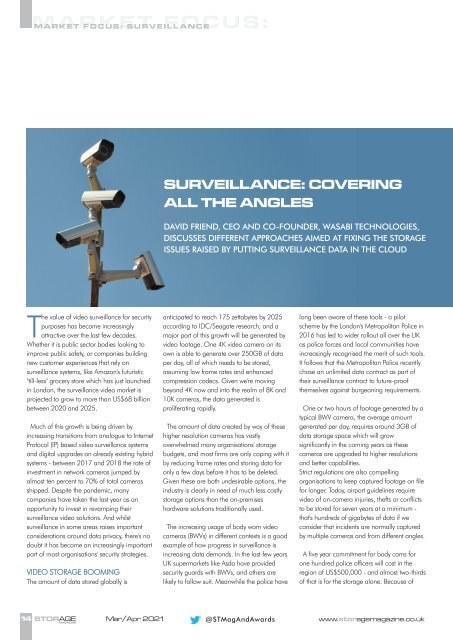Create successful ePaper yourself
Turn your PDF publications into a flip-book with our unique Google optimized e-Paper software.
MARKET FOCUS: SURVEILLANCE FOCUS:<br />
SURVEILLANCE: COVERING<br />
ALL THE ANGLES<br />
DAVID FRIEND, CEO AND CO-FOUNDER, WASABI TECHNOLOGIES,<br />
DISCUSSES DIFFERENT APPROACHES AIMED AT FIXING THE <strong>ST</strong>ORAGE<br />
ISSUES RAISED BY PUTTING SURVEILLANCE DATA IN THE CLOUD<br />
The value of video surveillance for security<br />
purposes has become increasingly<br />
attractive over the last few decades.<br />
Whether it is public sector bodies looking to<br />
improve public safety, or companies building<br />
new customer experiences that rely on<br />
surveillance systems, like Amazon's futuristic<br />
"till-less" grocery store which has just launched<br />
in London, the surveillance video market is<br />
projected to grow to more than US$68 billion<br />
between 2020 and 2025.<br />
Much of this growth is being driven by<br />
increasing transitions from analogue to Internet<br />
Protocol (IP) based video surveillance systems<br />
and digital upgrades on already existing hybrid<br />
systems - between 2017 and 2018 the rate of<br />
investment in network cameras jumped by<br />
almost ten percent to 70% of total cameras<br />
shipped. Despite the pandemic, many<br />
companies have taken the last year as an<br />
opportunity to invest in revamping their<br />
surveillance video solutions. And whilst<br />
surveillance in some areas raises important<br />
considerations around data privacy, there's no<br />
doubt it has become an increasingly important<br />
part of most organisations' security strategies.<br />
VIDEO <strong>ST</strong>ORAGE BOOMING<br />
The amount of data stored globally is<br />
anticipated to reach 175 zettabytes by 2025<br />
according to IDC/Seagate research, and a<br />
major part of this growth will be generated by<br />
video footage. One 4K video camera on its<br />
own is able to generate over 250GB of data<br />
per day, all of which needs to be stored,<br />
assuming low frame rates and enhanced<br />
compression codecs. Given we're moving<br />
beyond 4K now and into the realm of 8K and<br />
10K cameras, the data generated is<br />
proliferating rapidly.<br />
The amount of data created by way of these<br />
higher resolution cameras has vastly<br />
overwhelmed many organisations' storage<br />
budgets, and most firms are only coping with it<br />
by reducing frame rates and storing data for<br />
only a few days before it has to be deleted.<br />
Given these are both undesirable options, the<br />
industry is clearly in need of much less costly<br />
storage options than the on-premises<br />
hardware solutions traditionally used.<br />
The increasing usage of body worn video<br />
cameras (BWVs) in different contexts is a good<br />
example of how progress in surveillance is<br />
increasing data demands. In the last few years<br />
UK supermarkets like Asda have provided<br />
security guards with BWVs, and others are<br />
likely to follow suit. Meanwhile the police have<br />
long been aware of these tools - a pilot<br />
scheme by the London's Metropolitan Police in<br />
2016 has led to wider rollout all over the UK<br />
as police forces and local communities have<br />
increasingly recognised the merit of such tools.<br />
It follows that the Metropolitan Police recently<br />
chose an unlimited data contract as part of<br />
their surveillance contract to future-proof<br />
themselves against burgeoning requirements.<br />
One or two hours of footage generated by a<br />
typical BWV camera, the average amount<br />
generated per day, requires around 3GB of<br />
data storage space which will grow<br />
significantly in the coming years as these<br />
cameras are upgraded to higher resolutions<br />
and better capabilities.<br />
Strict regulations are also compelling<br />
organisations to keep captured footage on file<br />
for longer. Today, airport guidelines require<br />
video of on-camera injuries, thefts or conflicts<br />
to be stored for seven years at a minimum -<br />
that's hundreds of gigabytes of data if we<br />
consider that incidents are normally captured<br />
by multiple cameras and from different angles.<br />
A five year commitment for body cams for<br />
one hundred police officers will cost in the<br />
region of US$500,000 - and almost two-thirds<br />
of that is for the storage alone. Because of<br />
14 <strong>ST</strong>ORAGE <strong>Mar</strong>/<strong>Apr</strong> <strong>2021</strong><br />
@<strong>ST</strong>MagAndAwards<br />
www.storagemagazine.co.uk<br />
MAGAZINE

















